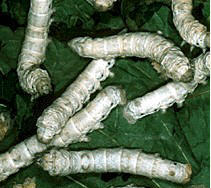

Older
Caterpillars
Silkworms will need to go home with the teacher or a child over the weekend since they need fresh leaves, and leaves dry out very quickly. The silkworms will shed their skin three times while growing. The shed skins are beige and usually roll up into a round wad. Sometimes the tiny silkworms will eat their shed skin. The larger ones don't. Each stage the silkworm goes through is called an "instar". First instar caterpillars are black. The second and third instars are grayish-white with black heads. The fifth and final instar has a white head and is shown in the picture on top of the page. In between each instar is a time of resting and molting. The Japanese say the silkworm is "sleeping".
The silkworm does 80% of its eating during the fifth instar. The silk glands now make up 25% of its body weight. The larva has increased its size 10,000 times since birth. If this happened to a six-pound human baby, it would weigh 60,000 pounds when it was grown! The final instar of the larval stage is 2-3/4 inches long, as you can see below.

In each instar, the caterpillar has six real legs (as do all insects). It also has five pairs of false legs on the rear of its body. The body is made up of thirteen segments, each of which has a black dot on the side. These dots are called spiracles, and the silkworm breathes through them.
Spinning silk
The caterpillars take about a month to get big enough to spin a cocoon. The caterpillars like to spin cocoons in toilet paper tubes (slice them in half like Life Savers), paper towel tubes (cut into six slices), or in egg carton bottoms. You can tell that they are ready to spin when they stop eating and turn yellowish. The picture below is a silkworm almost finished eating. Its skin looks tight and ready to burst. Just before they start spinning, the silkworm makes a wet, messy poop to rid its body of excess liquids.

When they get finger-sized, put sliced toilet paper tubes or egg cartons in their container. You can make a "cocoon condo" by stacking toilet paper tubes in a pyramid as show in the picture below. You can use glue or paper clips to hold them together.

The cocoon-spinning process takes about three days. When they are spinning, try not to disturb their threads or they will have to start all over again. Once the cocoons are all spun, remove dried-up leaves to prevent mold from forming.
To continue to the next stage in development, click on Spinning a cocoon..